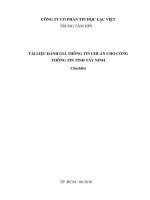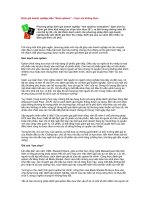tài liệu mã giả giả thuật
Bạn đang xem bản rút gọn của tài liệu. Xem và tải ngay bản đầy đủ của tài liệu tại đây (417.69 KB, 64 trang )
PseudoCode
Damian Gordon
Pseudocode
• The first thing we do when designing a
program is to decide on a name for the
program.
Pseudocode
• The first thing we do when designing a
program is to decide on a name for the
program.
• Let’s say we want to write a program to
calculate interest, a good name for the
program would be CalculateInterest.
Pseudocode
• The first thing we do when designing a
program is to decide on a name for the
program.
• Let’s say we want to write a program to
calculate interest, a good name for the
program would be CalculateInterest.
• Note the use of CamelCase.
Pseudocode
• The first thing we do when designing a
program is to decide on a name for the
program.
• Let’s say we want to write a program to
calculate interest, a good name for the
program would be CalculateInterest.
• Note the use of CamelCase.
Pseudocode
• So we start the program as:
PROGRAM CalculateInterest:
Pseudocode
• So we start the program as:
PROGRAM CalculateInterest:
• And in general it’s:
PROGRAM <ProgramName>:
Pseudocode
• Our program will finish with the following:
END.
Pseudocode
• Our program will finish with the following:
END.
• And in general it’s the same:
END.
Pseudocode
• So the general structure of all programs is:
PROGRAM <ProgramName>:
<Do stuff>
END.
SEQUENCE
Pseudocode
• When we write programs, we assume that the
computer executes the program starting at
the beginning and working its way to the end.
• This is a basic assumption of all algorithm
design.
Pseudocode
• When we write programs, we assume that the
computer executes the program starting at
the beginning and working its way to the end.
• This is a basic assumption of all algorithm
design.
• We call this SEQUENCE.
Pseudocode
• In Pseudo code it looks like this:
Statement1;
Statement2;
Statement3;
Statement4;
Statement5;
Statement6;
Statement7;
Statement8;
Pseudocode
• For example, for making a cup of tea:
Organise everything together;
Plug in kettle;
Put teabag in cup;
Put water into kettle;
Wait for kettle to boil;
Add water to cup;
Remove teabag with spoon/fork;
Add milk and/or sugar;
Serve;
Pseudocode
• Or as a program:
PROGRAM MakeACupOfTea:
Organise everything together;
Plug in kettle;
Put teabag in cup;
Put water into kettle;
Wait for kettle to boil;
Add water to cup;
Remove teabag with spoon/fork;
Add milk and/or sugar;
Serve;
END.
Pseudocode
• Or as a program:
PROGRAM MakeACupOfTea:
Organise everything together;
Plug in kettle;
Put teabag in cup;
Put water into kettle;
Wait for kettle to boil;
Add water to cup;
Remove teabag with spoon/fork;
Add milk and/or sugar;
Serve;
END.
SELECTION
Pseudocode
• What if we want to make a choice, for
example, do we want to add sugar or not to
the tea?
Pseudocode
• What if we want to make a choice, for
example, do we want to add sugar or not to
the tea?
• We call this SELECTION.
Pseudocode
• So, we could state this as:
IF (sugar is required)
THEN add sugar;
ELSE don’t add sugar;
ENDIF;
Pseudocode
• Or, in general:
IF (<CONDITION>)
THEN <Statements>;
ELSE <Statements>;
ENDIF;
Pseudocode
• Or to check which number is biggest:
IF (A > B)
THEN Print A + “is bigger”;
ELSE Print B + “is bigger”;
ENDIF;
Pseudocode
•
Adding a selection statement in the program:
PROGRAM MakeACupOfTea:
Organise everything together;
Plug in kettle;
Put teabag in cup;
Put water into kettle;
Wait for kettle to boil;
Add water to cup;
Remove teabag with spoon/fork;
Add milk;
IF (sugar is required)
THEN add sugar;
ELSE do nothing;
ENDIF;
Serve;
END.
Pseudocode
•
Adding a selection statement in the program:
PROGRAM MakeACupOfTea:
Organise everything together;
Plug in kettle;
Put teabag in cup;
Put water into kettle;
Wait for kettle to boil;
Add water to cup;
Remove teabag with spoon/fork;
Add milk;
IF (sugar is required)
THEN add sugar;
ELSE do nothing;
ENDIF;
Serve;
END.









